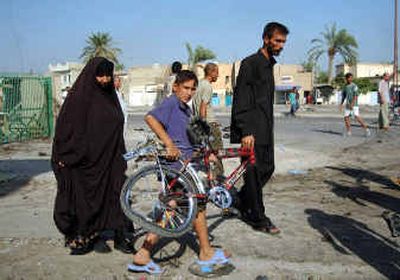At least 35 children die in bombings

BAGHDAD, Iraq – The last day of the worst month of car bombings in Iraq targeted the most vulnerable and proved the most horrifying.
Children gathering for candy from American soldiers at the opening of a sewage treatment plant bore the brunt Thursday of a series of guerrilla bombings that killed at least 35 youngsters and 14 adults. About 200 people – many of them children – were wounded in the attacks.
It was the worst single death toll of children since the United States invaded Iraq in March 2003.
“We were standing in front of the tank and they attacked the tank,” said Ziad Ismael Ibrahim, 9, who was being treated at Yarmouk Hospital for shrapnel wounds to an arm and leg. “The bomb exploded. I could not see anything – it was all dust and blood.”
Three bombs went off in succession beginning at 1 p.m. in the working-class Al-Amel neighborhood. Another car bomb had exploded earlier Thursday near Abu Ghraib prison west of Baghdad. And a fifth targeted Iraqi police in the northern city of Tal Afar.
The explosions brought to at least 43 the number of car bombings in September by insurgents opposed to the U.S.-led occupation and the interim Iraqi government. Even as U.S. military officials and Iraqi political leaders say they are getting better intelligence about the insurgents and thwarting more planned attacks, the pace of the killings has quickened.
Thursday’s bombings killed an American soldier and wounded 13 others, bringing the American death toll in Iraq to at least 75 for September.
It marked the fourth straight month that the U.S. death toll had climbed. The trend is unbroken since the interim government of Prime Minister Ayad Allawi assumed partial sovereignty in late June.
“Can’t the Americans arrange security? Can’t the Americans find a solution?” asked Layla Yunis, 45, who covered her mouth in pity as families with wounded children hurried down the hallways of Yarmouk Hospital. “We don’t want anything else. We just want security.”
Families gathered in small groups in the hospital courtyard, exchanging whispers. Some women wailed in grief.
A woman in a head-to-toe black chador, frantic, scurried around the courtyard asking everyone where her boy might be. It had been three hours since the blast, and her son was not in surgery, he was not in intensive care, he was not in the morgue.
The dead filled the morgue to the corners, and families had to step over bodies of friends and neighbors in search of kin. Hospital and Health Ministry officials put the death toll at 42, at least 35 of them children.
Inside the surgery wing, blood spotted the floors, soaked the sheets and stained clothes all around. Some youngsters lay two to a bed. Relatives crowded around cots of boys and girls with brave, scared, bloodied little faces.
“They were there for a celebration, a normal celebration,” said Ali Hassan, 46, whose 9-year-old nephew, Ahmed, was a mess of bandages and tubes and ointments. The boy, his face sallow, his eyelids fluttering, had already been operated on to remove shrapnel from his stomach, yet he lay there in the same bloodied T-shirt he wore when they brought him in.
“I don’t know who they were targeting,” Hassan said. “Were they targeting men? Were they targeting children?”
The afternoon had started out promising, the stuff of public-relations releases from an occupation force desperate to rebuild Iraq but facing violent rebellion and other, more mundane problems at nearly every turn.
American soldiers had joined Iraqi officials for a ribbon-cutting on a new sewage treatment plant. The soldiers were distributing candies, and a lucky few children would receive track suits.
Then the first bomb struck and, quickly, the second. A third blast a short distance away targeted Iraqi National Guard troops.
“I could see pieces of bodies everywhere – the heads, the arms, everything,” said Amal Rafeeq Mohammed.
Ten U.S. soldiers were wounded in the Baghdad bombings, two of them seriously, a military statement said. An American helicopter evacuated some of the wounded.
“When they attack the soldiers, why can’t they think about the children?” said Ismael Ibrahim, whose sons, 9-year-old Ziad and 12-year-old Ayad, were being treated at Yarmouk for shrapnel wounds. “Those who want to attack the Americans, why not go to their bases?”
Ibrahim said he expected his sons to recover quickly. Then looking around at other families at the hospital, he thanked Allah for that blessing.
“I will not let my children go to school now,” he said, with classes scheduled to open for the year Saturday. “I am too afraid.”
The car bombing in Tal Afar, the site last month of a rebel takeover of the town that was put down by U.S. troops, was aimed at the local police chief. He escaped, but at least four Iraqis were killed and 16 people were wounded, Iraqi and U.S. officials said.
The Abu Ghraib car bombing, on the western outskirts of Baghdad, targeted a compound housing the mayor’s office and a police station, an Iraqi police official told the Associated Press. An American soldier and at least two Iraqis were killed, officials said. Sixty people were reported wounded, including three American soldiers.